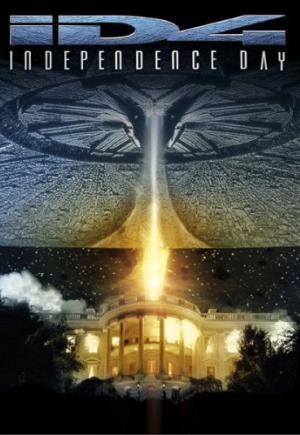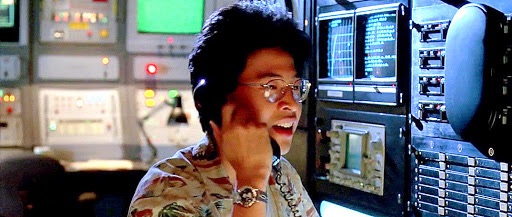The Sound Design of ID4

I chose to review a film that I’m pretty familiar with: Roland Emerich’s masterpiece, ID4 (Independence Day, 1996). This film has stood out for me on several levels that go beyond the sentimental memory of being 18 in 1996. It was one of the last films to exclusively utilize practical special effects. It pushes the alien invasion trope in science fiction into a contemporary time period while leaning into the canon established by Olson Wells. It also depicts characters that represent the cultural diversity of this country who work toward global unity. I could go on, but I’ll keep my commentary in line with the directive of this assignment: SOUND. To that end, my focus will (mostly) be on the opening sequence which is indicative of the rest of the film.
The opening shot takes place on the moon which is a pretty good indicator that the audio is all done in post unless Emerich gained access to a spaceship or the set where NASA faked the moon landing…. The score’s main theme begins to play slowly; it’s vaguely patriotic. Tinny transmissions from the first moon landing plays overlaid with beeps: “We came in peace for all mankind…” This detail is full of production value as it’s free of copyright but it also establishes the set: The Moon, which is in space. Moreover, it suggests a theme by indicating peaceful exploration and an optimistic hope for first contact. Lastly, it makes reference to mankind or humanity as a whole. Ronnie Reagan often said the only thing that would ever unite humanity is an alien invasion. Later, Emmerich makes that premise a central feature in ID4 by showing short clips of the invasion taking place in foreign cities around the planet.
I can hear a slight, low rumble (like an earthquake) that crescendos, becoming a more mechanical rumble. The passing mothership seems to get closer to the ‘mic’ then further away as it heads toward earth. The sound indicates the movement as well as giving us a hint about its immense size. On a side note: The alien mothership is described later in the film as being ¼ the size of the moon. Considering the lunar tidal effect, wouldn’t an object with such a huge mass orbiting much closer than the moon have some climatic effect of the planet? I’m not criticizing the scientific accuracy of ID4, I’m just pointing out that Emmerich could have signaled the arrival of the aliens with anomalous tidal events like storms or floods or earthquakes. Missed opportunity.
We hear the familiar plucky clack of a putter striking a golf ball. Alone, in the wee hours of the morning, a bored astronomer practices his short game in a room packed with equipment. A small radio plays REM: “It’s the end of the world as we know it…” Stipe seems to be referencing the plot while placing us in a time period: the ’90s. Suddenly, from one of the many devices, an innocuous mechanical hum turns into a repetitive signal, catching the attention of the young astronomer. For those of us familiar with Sagan’s story ‘Contact’ (adapted to film around the same time as ID4) the location of the cluttered lab is inferred; it’s SETI, perhaps in New Mexico. Even the young scientist’s wardrobe mimics those of the astronomers depicted in Contact. At this point, Emmerich has used only non-dialogue sound along with familiar visual tropes to front-load a ton of information. Later, when exposition through dialogue describes SETI picking up a signal that seems to be coming from the direction of the moon that indicates a massive object that is slowing down as it approaches earth the audience is ready to absorb the premise. Effectively, Emmerich tells us twice.
After a moment considering the signal, the young scientist reaches for a phone receiver which emits a ‘click’ that cuts to a ‘ring’ in a dimly lit bedroom. An older man picks up the phone, cutting off the ‘ring’ as he says in a sing-song voice: “If this isn’t an insanely beautiful woman, I’m hanging up.” As a reply, the young scientist back at the lab presses the receiver to a speaker that emits a repetitive signal. Hearing the signal, the older scientist jolts out of bed, hitting his head with an audible THUD. Through the phone line, we can hear the older scientist swearing. That last bit is naturalistic as the exclamations are somewhat distorted, being emitted by the landline connection. We hear the older scientist’s expletives as the younger scientist would presumably hear them. As an audience, we can identify with the younger scientists’ puzzled query: “Sir?”.

This humorous interaction is small and personal which contrasts the inherently big events that have been depicted, thus far. The themes are being established: The actions of a few motivated actors can have a monumental impact on the macro-scale. Or, unstoppable killer aliens can be defeated by the smallest of players: a virus. Emmerich uses audio contrasts such as the quiet of the lunar surface compared to the menacing rumble of the alien mothership; the melodic pop song compared to the disruptive signal from space. Each of these contrasts reflects the story as humans living in the first act is unceremoniously disrupted by the arrival of city-size alien spaceships. The thematic contrast as highlighted by the audio contrast builds tension which arguably culminates when cities around the globe are annihilated with resounding booms and the persistent hum of an energy beam.